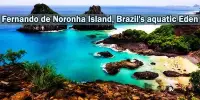Iceland has experienced one of the world’s fastest rates of growth in terms of tourism during the past ten years. In 2017, the Nordic country received almost 2 million foreign visitors, which is six times more than its entire population. The attention is well-deserved.
But 1,500 miles to the southwest, there is a similar-sized, ruggedly attractive, and similarly distant island called Newfoundland that most tourists still ignore, are unsure who owns, and can’t even pronounce.
Noo-fn-land (rhymes with “understand”), is a windswept but colorful Canadian island the size of Virginia that may pass for a mix of Scotland, Norway, and the aforementioned Iceland.
Coupled with mainland Labrador as a single province, Newfoundland is home to the most fantastic fjord in North America, the first Viking settlement on the continent (some 400 years before Columbus reached the New World), remarkable hiking trails, year-round sea encounters and sophisticated cuisine.
What’s more, you can comfortably travel the island by road trip on the Trans-Canada highway to get to the best coastal gems. The pristine Newfoundland is worth the extra planes needed to get there, even though it doesn’t have as much fire and ice as Iceland. If you like to share your next journey with fewer people and at a slower pace, read on to see why.
A Canadian favorite
Only 100,000 of the half million tourists the province receives each year are foreigners, with the remaining 80% being mainland Canadians. Therefore, Canadians have been visiting this province for decades and hold it in even higher respect than some of their more well-known provinces, such as British Columbia and Alberta, while the rest of the world has yet to discover its Ireland-like charm.
Newfoundland’s distinctive good looks are a big, if not primary, reason for that. That goes for the entire coastline as well as the bigger national parks in the western region.
Although the island is not as volcanic, mountainous or glacier-filled as the titular Iceland comparison, it’s just as colorful, enjoys significantly more wildlife and will cause nearly ever visitor to wonder in awe, “Where in the world am I?”
Stunning sights
For the few who venture to Newfoundland, most of them come for one (or all) of the following: the immortal views of Western Brook Fjord (which is ironically called a “pond” but looks like a slightly shorter Yosemite flooded by navy blue water), year-round whale sightings (both humpback and minke), and blue arctic icebergs that migrate every summer by the thousands down from Greenland to Newfoundland’s northern and eastern shores.
The fjord itself can be reached by boat in three hours, on foot in a day via the scenic eastern gulch, or as part of a multiday hiking trek over the Long Range Traverse across greater Gros Morne National Park, the island’s biggest tourist destination.
Not far from there, travelers can watch the sun set over the Atlantic at the arch-filled and aptly named Arches Provincial Park.
Wildlife encounters
In the popular town of Bonavista, visitors stand the greatest chance of whale sightings. They can also hike the Skerwink Trail, which winds through the island’s second-best hike on account of its oceanfront location and craggy, emerald-covered sedimentary rock.
In the town of Cape St. Mary’s, tourists can maximize their puffin and bird sightings. For two weeks every summer, officials lift the annual cod moratorium so visitors can freely fish without a permit (check with guides for exact dates).
But the most moving “animal” isn’t even an animal. When encountered, 10,000-year-old icebergs can hiss, crackle and pop while glowing a luminescent and lively blue.
World heritage
Contrary to what you may recall from elementary school, Newfoundland is where the first recorded European settlement in North America took place.
Located on the tip of the Great Northern Peninsula, L’Anse aux Meadows National Historic Site displays 1,000-year-old Norse or Viking archaeological settlements.
In the outpost communities of Fogo Island and Change Islands, visitors can wonder just how isolated and difficult life can sometimes be in the farthest corners of Earth.
But Newfoundland heritage also lives in the present. You can find it among the colorful coastal houses in St. John’s, Newfoundland and Labrador’s capital and home to close to 200,000 people.
You can find it at relaxing Cape Spear, where an 1836 lighthouse marks the most easterly point of North America. You can find it along the East Coast Trail, which serves as the spiritual if unofficial “last section” of the Appalachian Trail. And you can certainly find it in the delectable and colloquial bakeapple (aka “cloudberry”) jam, the world-class seafood and the independent but welcoming residents.
Earth’s four corners
In a word, Newfoundland is otherworldly, even if it’s far less familiar than Iceland. Furthermore, Newfoundland has that “corner of the world” feeling.
Is Newfoundland the next Iceland? Probably not.
But it’s not necessary to be for you to enjoy the area’s remote and enticing beauty, forgotten-by-time landscapes, and picturesque seascapes. For now, Newfoundland remains a well-kept and sleepy secret.
Best time to visit: May-June for icebergs; June-August for heavenly hiking weather; May-September for whales. Getting there: From the United States. one or two connecting flights are required to get to St. John’s.
















